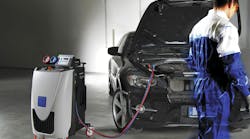Vehicle repairers have watched a slow hemorrhage of state vehicle safety inspection programs for a number of years. These programs go back to 1926 beginning with a voluntary program in Massachusetts and increased to 31 states plus the District of Columbia in 1975. In addition to voluntary programs and mandatory state programs, the federal government, through the Highway Safety Act of 1966, mandated that the U.S. Department of Transportation prescribe uniform standards for state highway safety programs.
The 1990 Clean Air Amendments encouraged states to establish emissions inspection and maintenance programs to improve air quality. These programs were regularly attacked by the media, political pundits and even some in the auto industry. Unfortunately, a number of policymakers in safety inspection states took advantage of this movement and compared safety inspection to problems with emissions inspection and maintenance. Arguments against vehicle safety inspection programs included costs to the consumer, inconvenience of the inspection, little evidence that inspection prevented accidents, injuries and deaths, just another tax, etc.
Although programs in Missouri, Texas, Pennsylvania and North Carolina survived frequent attacks, the industry saw inspection programs in Mississippi, New Jersey, District of Columbia eliminated. As of this writing, we have 15 state programs.
The Automotive Service Association (ASA), along with the American Association of Motor Vehicle Administrators and other members of the automotive aftermarket, held numerous conferences during CARS each year in Las Vegas, Nevada. Of late, ASA held Vehicle Safety Inspection Forums in Pennsylvania and Missouri. Although well attended with excellent program content, these forums have not prevented the onslaught of attacks on state inspection programs in those states.
This past legislative session in Texas, the inspection program came close to ending after an aggressive legislative push. It is anticipated that we will see legislation to terminate the Texas program again in this next session. Only after aftermarket groups joined together in opposition to the bill were we able to stop efforts to kill the inspection program.
In Missouri, the authorizing committee, approved legislation to end the inspection program as Missouri repairers know it. Missouri’s program has been the template offered to states to demonstrate how a successful program is structured. ASA testified against the bill and initiated a grassroots effort to stop it. Other aftermarket associations joined the fight to protect Missouri’s program. The Legislature adjourned without passing the legislation and the bill is dead for the year.
So how can we change the conversation about vehicle safety inspection? As repairers, we have to work closer with the aftermarket and other industry colleagues to educate members of the industry, consumers and policymakers about the value of these programs. The last sessions’ industry efforts in Texas and Missouri demonstrate that we can stop these very harmful bills when we join together.
In addition, we have to make a better case as to why these programs should be in all 50 states and not just in less than a third of the states. Data is critically important. We have not always had the data necessary to make the best case for protecting or establishing programs. The National Highway Traffic Safety Administration (NHTSA) has not been an encourager of these programs despite the U.S. Government Accountability Office (GAO) report references to the need for more NHTSA involvement. At a minimum, NHTSA should pursue data relative to programs’ protecting the motoring public from accidents, injuries and deaths.
Whether it’s providing consumers with important information about recall efforts or becoming part of the vehicle safety firewall as new technologies are deployed (i.e. autonomous vehicles), the arguments for these programs need updating. NHTSA has an opportunity to be part of this movement. It’s not too late.
Unless we take a more aggressive view as to the importance of these programs for safety, they will continue to be at risk and will likely miss an opportunity to be part of the revolution in automotive technology.

